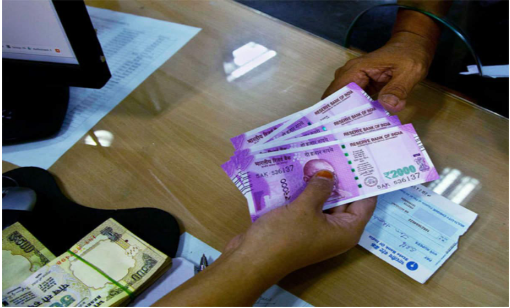Demonetization (2016)

It has almost been six years since the demonetization of old thousand and five hundred rupees notes took place. In this article we would be going through the impacts of this demonetisation on our country’s economy.
Firstly, coming to what does demonetisation refer to and how did it take place in our country.
Demonetization is withdrawal of a coin, note, or precious metal from use as legal tender.
The plan to demonetise the 500- and 1000-rupee banknotes was initiated between six and ten months before it was a report by the state bank of India (SBI). In may 2016, the Reserve Bank of India had started preparing for new banknotes and confirmed the design of 2,000-rupee banknotes in august 2016. The printing of new banknotes started in October when the news stories of forthcoming new banknotes appeared in the media. On 27 October 2016, the Hindi daily Dainik Jagran published a report quoting RBI sources speaking of the forthcoming of 2,000-rupee banknotes alongside withdrawal of 500- and 1000-rupee banknotes. On 21 October 2016, The Hindu Business Line had also published a report on the forthcoming 2,000-rupee banknote.
On 8 November 2016, the government of India announced the demonetisation of all 500- and 1000-rupee banknotes of the Mahatma Gandhi series. It also announced the issuance of new 500- and 2000-rupee banknotes in exchange for the demonetised banknotes. Our then, prime minister Narendra Modi claimed that the action would curtail the shadow economy, increase cashless transactions, and reduce the use of illicit and counterfeit cash to fund illegal activity and terrorism.
Before this demonetisation had priorly taken place in two occasions- once in 1946 and once in 1978 and in both the cases, the goal was to combat tax evasion via black money held outside the formal economic system.
The process of cash exchange and withdrawal:
- The Reserve Bank of India stipulated that the demonetised banknotes could be deposited with banks over a period of fifty days until 30 December 2016. The banknotes could also be exchanged for legal tender over the counter at all banks. The limit for these exchanges were 4,000-rupee per person from 8 to 13 November, it was increased to 4,500 -rupee from 14 to 17 November, and then it reduced to 2,000-rupee from 18 to 25 November. The exchange of banknotes was stopped completely on 25 November. International airports also facilitated an exchange of banknotes for foreign tourists and out-bound travellers, amounting to a total value of 5,000-rupee per person. Fuel pumps, government hospitals, railway and airline booking counters, state-government recognised dairies and ration stores, and crematoriums were allowed to accept the demonetised banknotes until 2 December 2016.
Cash withdrawals from bank accounts were restricted to 10,000-rupee per day and 20,000rupee per week per account from 10 to 13 November. This limit was increased to 24,000-rupee per week from 14 November 2016. A daily limit on withdrawals from ATMs was also imposed varying from 2,000-rupee per day until 14 November, and 25,00-rupee per day until 31 December.
Impacts:
Now coming to the impacts of demonetisation, it can be said that demonetisation had both positive and some negative impacts. So here I will be listing out those below,
The positive impact:
- Check on food inflation:
Owing to a substantial withdrawal of currency in circulation, demonetisation led to a check on food inflation in the economy. Accordingly, there was a sharp fall in food inflation by about 240 basic points between November 2016- January 2017. - The removal of fake currency:
the fake notes or counterfeit currency notes was second big target of Modi’s demonetisation. The number of counterfeit notes decreased after the demonetisation period. - Surge in cash deposits:
There was a surge in cash deposits in Jhan Dan Accounts. According to RBI estimate, Rs. 11.5 lakh crore money was deposited in the banks following demonetization. - Clearing of overdue:
People rushed to clear their overdue related to bank loans, property tax, electricity bills etc. this was because the government provided a window of clearing the old dues by using the old(demonetized) currency.
- Tax compliance:
A shift from cash to banking transactions led to better tax compliance. The government recorded noticeable rise in tax to GDP ratio.
- Real estate cleansing:
demonetisation led to deep cleansing of real estate sector. Prices in real estates have crashed and housing is becoming more affordable for the middle and lower sections of the society. - Push towards digitization:With cash almost disappearing from the market, people were driven to digital modes of transaction.
- Terrorism and internal security:
initially there were a decrease in the activities and attacks by Maoist and Naxalite radical groups, which were attributed to lack of finance following demonetization
The negative impacts:
- Black money:
one of the main aims of the government while implementing demonetisation was to purge the black money. The government estimated that ₹5 lakh crore, or approximately 20%, of the demonetised banknotes would be permanently removed from circulation. However, according to a 2018 report from the RBI, 99.3% of the demonetised banknotes, or ₹15.30 lakh crore of the ₹15.41 lakh crore that had been demonetised, were deposited with the banking system. The banknotes that were not deposited were worth ₹10,720 crore. Commentators concluded that the government had failed in its aim of purging black money from the economy. - Shortage of cash:
The scarcity of cash due to demonetisation led to chaos, and people faced difficulties in depositing or exchanging the demonetised banknotes due to long queues outside banks and ATMs across India. - Stock market:
As a combined effect of demonetisation and the US presidential election, the stock market indices dropped to an around six-month low in the week following the announcement.
- Employment:
There was a loss of jobs and a decline in wages due to demonetisation, particularly in the unorganised and informal sector and as well as in small enterprises.
This demonetisation was such a step which impacted the economy to the most extent. There are several initiatives and steps which the government of India has taken which have impacted the country’s economy, but the effect and impact of demonetisation by far can be said as to be the greatest.



Be Ethical and Responsible while commenting.
-1 OR 5*5=25
!(()&&!|*|*|
-1 OR 5*5=26
^(#$!@#$)(()))******
http://dicrpdbjmemujemfyopp.zzz/yrphmgdpgulaszriylqiipemefmacafkxycjaxjs?.jpg
-1' OR 5*5=25 --
-1' OR 5*5=26 --
/etc/shells
../../../../../../../../../../../../../../etc/shells
-1" OR 5*5=25 --
c:/windows/win.ini
-1" OR 5*5=26 --
bxss.me
-1' OR 5*5=25 or 'h1FDcRGN'='
Http://bxss.me/t/fit.txt
-1' OR 5*5=26 or 'h1FDcRGN'='
-1" OR 5*5=25 or "0HCuUK3s"="
http://bxss.me/t/fit.txt?.jpg
-1" OR 5*5=26 or "0HCuUK3s"="
*if(now()=sysdate(),sleep(15),0)